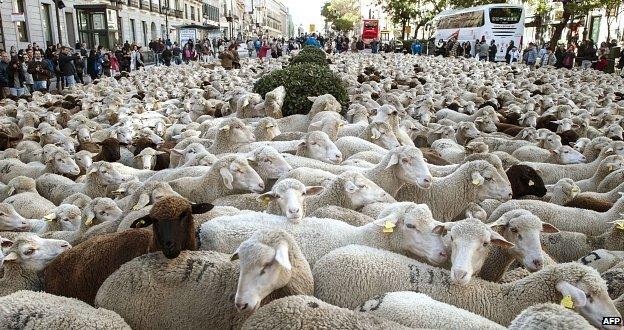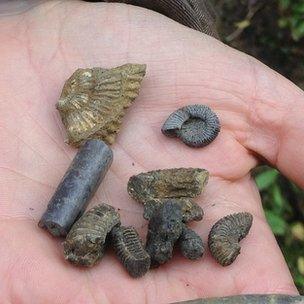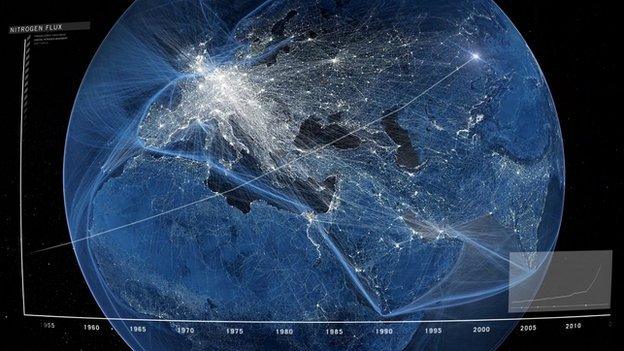Leaving our mark: Fossils of the future
- Published

The vast number of farm animals means that their odds of geological posterity are better than most
From our cities, to our farms, to our rubbish, humans have firmly stamped their mark across the planet. In part two of a two-part feature, Andrew Luck-Baker, from the BBC's Radio Science Unit, explores the legacy our civilisation will leave in the rocks of the future. You can read part one here.
Humanity's impact on the globe is so great and varied that we have launched a new geological time period in the Earth's history. Its name is the Anthropocene - the human epoch.
Fossil fuel emissions, climate change, agriculture, accelerated species extinction, chemical pollution and megacities will all express themselves in various ways in sediments in the seas, lakes and rivers in our times, scientists say.
Millions of years from now, those layers of sediment will have been compacted into rock such as sandstones, mudstones and limestones.
But what traces of human civilisation would future scientists find in the strata of the Anthropocene epoch?
One feature of the fossil record we are creating for the basal Anthropocene strata is unlike any past geological transition.
Millions of years from now, palaeontologists will likely excavate a disproportionately large number of bones belong to large to medium-sized mammals. Weirdly, they may think, the fossils are almost entirely of just a small handful of species. And their bones are on every continent apart from Antarctica.
Their discoveries will be a sample of our cows, sheep, goats and pigs which we have selected, transported and reared in their billions to feed the seven billion of us.
Consider animal demographics in an intensive agricultural world, says Jan Zalasiewicz: "Instead of having a natural terrestrial ecosystem consisting of two or three hundred vertebrate species all coexisting and all being moderately common, we and the creatures we keep have suddenly exploded as populations."
About 60% of the weight of all the back-boned animals on the Earth's surface today is our livestock. The mass of all the people takes up another 30%. The remaining nine or so percent is all of the wild creatures.

Fossil ammonites and belemnites are ubiquitous today
Any individual land animal's chances of being fossilised are extremely poor. Most fossils originate at sea where burials are quick. But because there are so many domesticated creatures, their odds of geological posterity are better than most. It is true we try to keep them out of harm's way until it is time to eat them.
And when we are finished with them, most of the disarticulated leftovers are thrown away or processed, says agricultural ecologist Earle Ellis of the University of Maryland Baltimore County.
However, other researchers speculate that enough livestock die on the range or get swept away in floods for them to take more than their fair share of the coming palaeontological limelight in the Anthropocene boundary layers.
The farm animal take-over and the extinction of wild species are not unconnected phenomena. Over the centuries, we have turned vast tracts of natural habitat such as forests into grazing land or fields in which we grow crops for animal feed or fodder. Then there is all the farmland on which we grow food crops for ourselves. About 40% of the planet's ice-free land surface is now used for agriculture.
There is a whole branch of palaeontology devoted to fossil pollen - palynology. In one million years, its practitioners might be excused their drooping eyelids as they peer down their microscopes at Anthropocene sediment samples. Again and again, chances are they will see an awful lot of maize, wheat, soya and oil seed rape pollen grains in comparison to other plant species.
Bone beds?
Given the numerical success of our species, some of us are also bound to end up as fossils. They will not be in quantities reflecting the current human population of seven billion - and the many more it took to get to that number. The remains of most people are cremated to ash or buried in airy holes in soil where our bones crumble to dust.
However, rich Homo sapiens fossil hunting grounds of the future could be in the nascent strata forming in places such as the coastal English Channel and the Mekong Delta.
In addition to cow bones and maize pollen, modern agriculture will leave another kind of pervasive trace in Anthropocene sediments. It is a chemical one which will stand-out to any far future geochemists as strikingly as the so-called iridium spike which today's Earth scientists use to demarcate the end of the age of dinosaurs.

The Anthropocene's equivalent of the element iridium is nitrogen
Iridium is a metal which is rare in our planet's crust but more abundant in many asteroids and meteorites. Its detection at unearthly levels in rocks 65 million years old was the first evidence in the case for an asteroid causing the mass extinction and global environmental mayhem that ended the Cretaceous period and began the Tertiary period.
The Anthropocene's equivalent of iridium is nitrogen - although there will be other candidates (such as heavy metals, and carbon isotope ratios characteristic of fossil fuel emissions) for geochemists of the far future to identify as the chemical signature of the new epoch's dawn.
All over the world, since the mid-20th Century, sediments have become measurably enriched in 'reactive' nitrogen - nitrogen oxides and ammonium compounds. The causes are man made and have come to dominate Nature's global nitrogen cycle.
According to Alex Wolfe, an Earth scientist at the University of Alberta, Edmonton: "We went from a planet where nitrogen was in short supply to a planet that's literally awash with nitrogen - and this (has happened), in a period of only a few decades."
Synthetic fertiliser production and fossil fuel burning are responsible for this.
Lake clue
Nitrogen is by far the most abundant element in the Earth's atmosphere but most of it stays aloof in a form which living things can't use. Until the 20th Century, the nutrient element only came to Earth in a reactive form that is usable by plants and animals, thanks to certain microbes in soil and water (and to a smaller extent in lightning strikes). Bacteria evolved the necessary chemistry to "fix" nitrogen from the air, about two billion years ago.
Then in the early 20th Century, German chemist Fritz Haber invented a high temperature-high pressure technique to convert atmospheric nitrogen into ammonia. The subsequent industrial production of billions of tonnes of synthetic nitrogen fertilisers - particular after the 1950s - have flooded terrestrial and aquatic ecosystems with reactive nitrogen, and supported the century's human population explosion.
A similar amount of reactive nitrogen has been created as a by-product of the combustion of coal, oil and natural gas in air inside the world's power stations and motor vehicles.
Fossil fuel burning and fertiliser manufacture now take more nitrogen from the atmosphere than all of the planet's nitrogen-fixing microbes - and there are a lot of those bugs out there.
Even the remotest places are touched by all this liberated nitrogen. Alex Wolfe and colleagues have sampled and chemically analysed the layers of sediments at the bottom of lakes in high alpine zones and the Arctic.
The top one or two centimetres of lake deposits are enriched in nitrogen compounds. This nitrogen also bears the isotopic fingerprint of nitrogen derived through the inorganic processes of fertiliser manufacture and fossil fuel burning, and not of the way microbes do it.
"I firmly believe that should future generations of geologists come back, they will identify these features as pervasive in the geological sense," says Professor Wolfe.
"This is one of the primary reasons that my colleagues and I are very much in favour of erecting a new geological boundary that would separate the Holocene (which is the period of relative climate stability of the last 10 000 or so years and which has permitted the development of societies) with this post-Holocene period that we call the Anthropocene, which has demonstrable evidence of the human strong-hold at the planetary scale."
Discovery: The Age We Made is a four part series on the BBC World Service. It is broadcast on Mondays at 1932 and 0432 GMT, Tuesdays at 1132 GMT and Sundays at 0132 GMT. Each episode is available as a download after airing at http://www.bbc.co.uk/programmes/p002w557
The series is presented by Gaia Vince and produced by Andrew Luck-Baker.
- Published1 November 2012
- Published26 March 2012
- Published11 May 2011